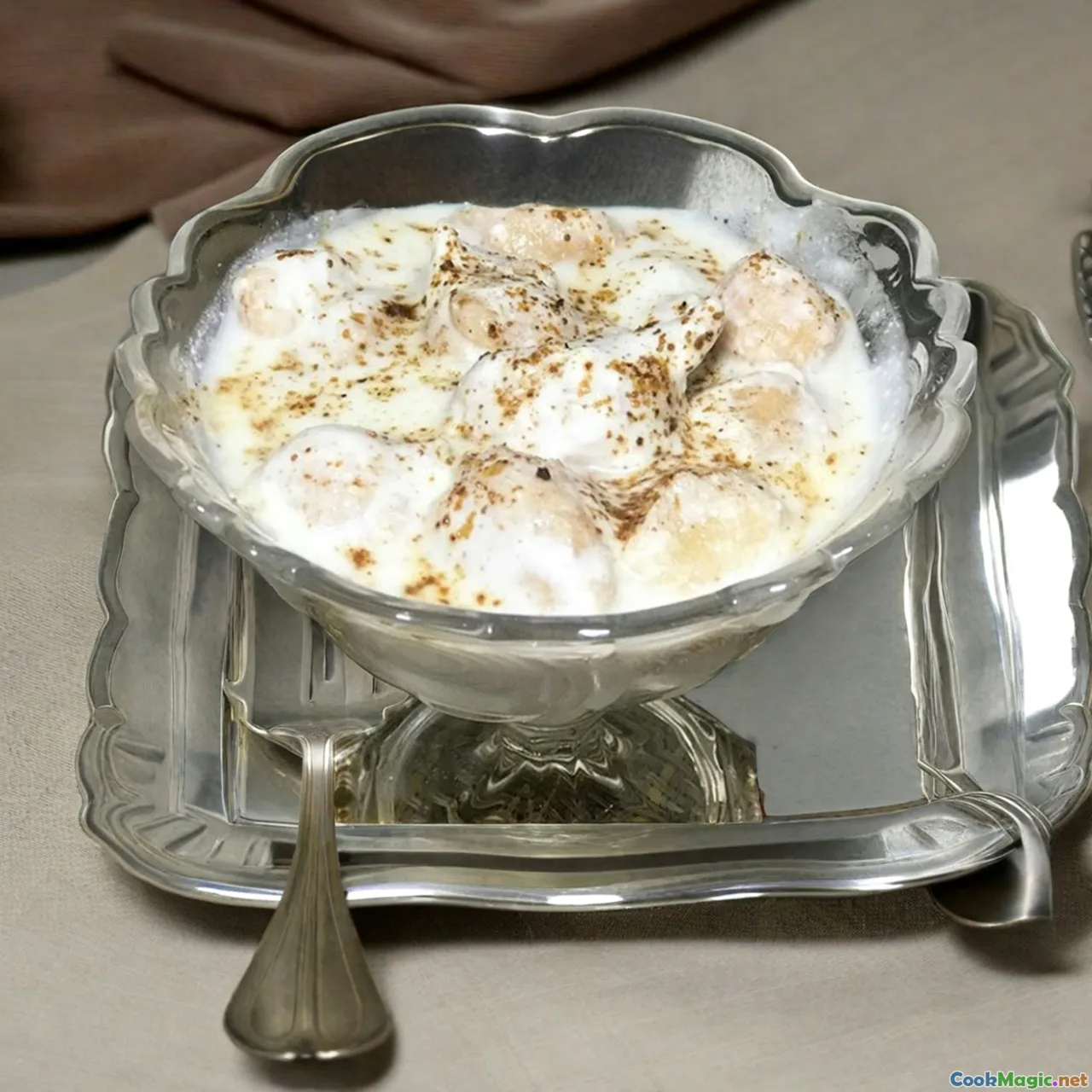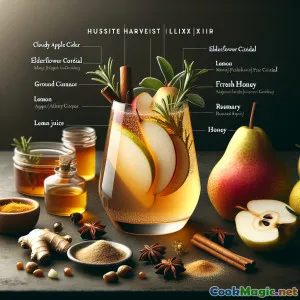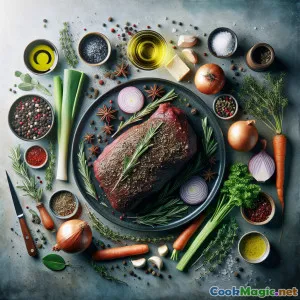
Chén Sữa Nhựa Thông & Lúa Mạch: Một Hương Vị Anh Quốc
(Birch Sap & Barley Cream Pots: An English Delight)
(0 Đánh giá)0
1,203
tháng 7 14, 2025
Báo cáo sự cố
Nguyên liệu
-
60 grams Lúa mạch thủ lòng đào
(Rửa sạch dưới nước lạnh)
-
300 ml Sữa nguyên kem
(Nấu lúa mạch)
-
200 ml Nước dịch cây bạch dương
(Tươi hoặc đóng chai; có thể thay thế bằng nước dừa với vị nhẹ hơn)
-
250 ml Kem đôi
(Để tạo độ béo và kết cấu mượt mà)
-
60 grams Đường cát mịn
(Điều chỉnh theo khẩu vị tùy thuộc vào độ ngọt của mạch nha)
-
3 large Lòng đỏ trứng
(Ở nhiệt độ phòng)
-
1 whole Vỏ cây vanilla
(Bổ đôi và bỏ hạt, hoặc sử dụng 1 thìa cà phê dầu vanilla)
-
1/4 tsp Muối biển
(Tăng cường hương vị)
-
2 tsp Mật ong
(Hoa dại kiểu Anh, tốt nhất để rắc lên món ăn)
-
20 grams Hạt phỉ rang
(Thái sơ qua, để trang trí)
(Rửa sạch dưới nước lạnh)
(Nấu lúa mạch)
(Tươi hoặc đóng chai; có thể thay thế bằng nước dừa với vị nhẹ hơn)
(Để tạo độ béo và kết cấu mượt mà)
(Điều chỉnh theo khẩu vị tùy thuộc vào độ ngọt của mạch nha)
(Ở nhiệt độ phòng)
(Bổ đôi và bỏ hạt, hoặc sử dụng 1 thìa cà phê dầu vanilla)
(Tăng cường hương vị)
(Hoa dại kiểu Anh, tốt nhất để rắc lên món ăn)
(Thái sơ qua, để trang trí)
Dinh dưỡng
- Khẩu phần: 4
- Kích thước khẩu phần: 1 ramequin (150ml)
- Calories: 350 kcal
- Carbohydrates: 33 g
- Protein: 7 g
- Fat: 21 g
- Fiber: 2.5 g
- Sugar: 13 g
- Sodium: 70 mg
- Cholesterol: 134 mg
- Calcium: 115 mg
- Iron: 1.2 mg
Hướng dẫn
-
1 - Nấu lúa mạch với sữa:
Rửa sạch đại mạch đã nhồi và cho vào một chiếc nồi nhỏ cùng với sữa tươi. Đun sôi nhẹ và nấu, không đậy nắp, cho đến khi đại mạch chín mềm, khoảng 25 phút. Thường xuyên khuấy để tránh dính. Để nguội một chút và để sang một bên.
-
2 - Xay để tạo độ béo mịn:
Đổ gạo lứt đã nấu chín và phần sữa còn lại vào máy xay sinh tố. Xay đều cho đến khi hỗn hợp mịn nhất có thể. Lọc qua rây lọc mịn để loại bỏ vỏ gạo còn sót lại nhằm tạo kết cấu mượt mà hơn.
-
3 - Ngâm Ép Tinh Dầu Bạch Dương và Kem:
Trong một chiếc nồi nhỏ sạch, kết hợp nước ép cây bạch dương, kem tươi, hỗn hợp lúa mạch đã lọc và hạt của quả vani (nếu sử dụng). Để nhẹ nhàng làm nóng, khuấy liên tục, chỉ đến khi hơi sương xuất hiện nhưng không sôi.
-
4 - Chuẩn bị lòng đỏ trứng và đường:
Trong khi đó, đánh đều lòng đỏ trứng với đường caster và muối biển trong một bát lớn cho đến khi màu nhạt hơn và hơi đặc lại.
-
5 - Nêm gia vị và trộn đều:
Từ từ đổ khoảng một phần ba kem lót từ cây sồi-ngũ cốc vào hỗn hợp trứng trong khi khuấy liên tục. Khi đã làm nóng đều, hãy khuấy hỗn hợp trứng trở lại chảo cùng phần chất lỏng nóng còn lại.
-
6 - Nấu nền kem trứng:
Trên lửa nhỏ, khuấy đều hỗn hợp custard liên tục cho đến khi đặc lại đủ để phủ đều lên thìa (khoảng 82°C nếu dùng nhiệt kế). Không để sôi.
-
7 - Làm lạnh trong chén ramekin:
Chia phần thành bốn ramekin dung tích 150ml. Để nguội đến nhiệt độ phòng, sau đó đậy và để trong tủ lạnh ít nhất 2 giờ cho đến khi đông lại mềm.
-
8 - Trang trí và trình bày:
Để trình bày, rưới một chút mật ong Anh trên trên cùng và rắc lên trên hạnh nhân phô mai rang nhỏ, nếu thích. Dùng lạnh và kem mịn.
Rửa sạch đại mạch đã nhồi và cho vào một chiếc nồi nhỏ cùng với sữa tươi. Đun sôi nhẹ và nấu, không đậy nắp, cho đến khi đại mạch chín mềm, khoảng 25 phút. Thường xuyên khuấy để tránh dính. Để nguội một chút và để sang một bên.
Đổ gạo lứt đã nấu chín và phần sữa còn lại vào máy xay sinh tố. Xay đều cho đến khi hỗn hợp mịn nhất có thể. Lọc qua rây lọc mịn để loại bỏ vỏ gạo còn sót lại nhằm tạo kết cấu mượt mà hơn.
Trong một chiếc nồi nhỏ sạch, kết hợp nước ép cây bạch dương, kem tươi, hỗn hợp lúa mạch đã lọc và hạt của quả vani (nếu sử dụng). Để nhẹ nhàng làm nóng, khuấy liên tục, chỉ đến khi hơi sương xuất hiện nhưng không sôi.
Trong khi đó, đánh đều lòng đỏ trứng với đường caster và muối biển trong một bát lớn cho đến khi màu nhạt hơn và hơi đặc lại.
Từ từ đổ khoảng một phần ba kem lót từ cây sồi-ngũ cốc vào hỗn hợp trứng trong khi khuấy liên tục. Khi đã làm nóng đều, hãy khuấy hỗn hợp trứng trở lại chảo cùng phần chất lỏng nóng còn lại.
Trên lửa nhỏ, khuấy đều hỗn hợp custard liên tục cho đến khi đặc lại đủ để phủ đều lên thìa (khoảng 82°C nếu dùng nhiệt kế). Không để sôi.
Chia phần thành bốn ramekin dung tích 150ml. Để nguội đến nhiệt độ phòng, sau đó đậy và để trong tủ lạnh ít nhất 2 giờ cho đến khi đông lại mềm.
Để trình bày, rưới một chút mật ong Anh trên trên cùng và rắc lên trên hạnh nhân phô mai rang nhỏ, nếu thích. Dùng lạnh và kem mịn.
Thông tin thêm về: Chén Sữa Nhựa Thông & Lúa Mạch: Một Hương Vị Anh Quốc
Birch Sap and Barley Cream Pots
Summary
This wholly original recipe for Birch Sap and Barley Cream Pots captures the gentle awakening of an English spring in a delicate, creamy dessert bowl. Combining the subtle, natural sweetness of birch sap with the nutty, old-world flavors of barley, and elevating it all with rich dairy and softly set custard, this dish blurs the lines between modern British innovation and age-old traditions. Its unassuming, creamy aesthetics hint at something more interesting upon first spoonful—an earthy complexity and layers of silky, gentle sweetness.
History and Cultural Significance
Birch sap, gathered from centuries-old woodland traditions, was once a celebrated ingredient in the Northern Hemisphere—tapped for just a few short weeks each spring. In the UK, though largely forgotten in mainstream cuisine, folklore remembers birch sap as a rejuvenating 'British tonic,' sometimes fermented into wine or mixed into healing concoctions. Barley’s role as a staple cereal can be traced from Neolithic times to roots in rustic British desserts and hearty stews, symbolizing resilience, comfort, and an affinity with the landscape.
Combining birch sap with barley in a creamy custard was inspired by traditional milk puddings and contemporary farmhouse desserts, but here given a new voice—bridging foraged, historic flavors and classic dessert typology.
Unique Aspects and Personal Notes
Birch Sap and Barley Cream Pots stand out not just for their writeup of “wild sophistication:”
-
The birch sap brings unique complexity, lightly floral, slightly sweet, unlike anything sugar or syrup could impart. Using birch sap as a base (where you might otherwise reach for milk, water, or coconut water) coaxes out woodsy, sappy nuances and gently perfumes the dessert.
-
Barley lends nutty undertones and provides a textural base for the custard when rendered ultra-smooth. It bulks the cream without heaviness, forming the bridge between tradition and elegance.
-
The slow, low cook and careful tempering of egg yolks ensure an unctuous, gentle set—not quite a thick jelly, more opulent than most milk puddings, yet firmer than classic pouring custard.
-
Lightly sweetened, with a dash of honey to serve, it needs little embellishment: a contrast of roughly chopped hazelnuts highlights the woodland origins and counters the creaminess, while a use of vanilla is purely optional—leaning into (or away from) the pure birch-milk aroma as you wish.
Tips & Notes
- Sourcing birch sap can be the main barrier; look for it bottled online or at specialty food stores during spring. If unavailable, slightly diluted maple water or even coconut water makes a gentle and neutral substitute, though each lacks pure birch nuance.
- The barley cream achieves true silkiness by thorough blending and straining—don’t rush this part.
- If desired, infuse other seasonal wild herbs (like meadowsweet or elderflower) into the cream just before straining, amplifying the wild character of the dessert.
- Keeping the yolk-cream mixture below boiling (82°C/180°F) prevents curdling, giving that opulent texture prized in classic pots de crème.
- These set softly for an impressive table finish but keep hands-off when cooling; the chilling step is essential to their success.
Variations and Serving
You may experiment with nut toppings—try toasted pecans or almonds. Birch syrup (used with restraint) works as a garnish for darker caramel bitterness, or swap in seasonal berries and a little buttermilk for a tart contrast. Best served foraged-ingredient dinners, a woodland afternoon tea, or simply to evoke lush English meadows wherever you are. If serving to guests, the story of birch sap’s scarcity and tradition could become the star conversation.
This unique dessert pot manages to be both subtly wild and beautifully refined—an unmistakable taste of the British landscape, reimagined for today’s palate.
























